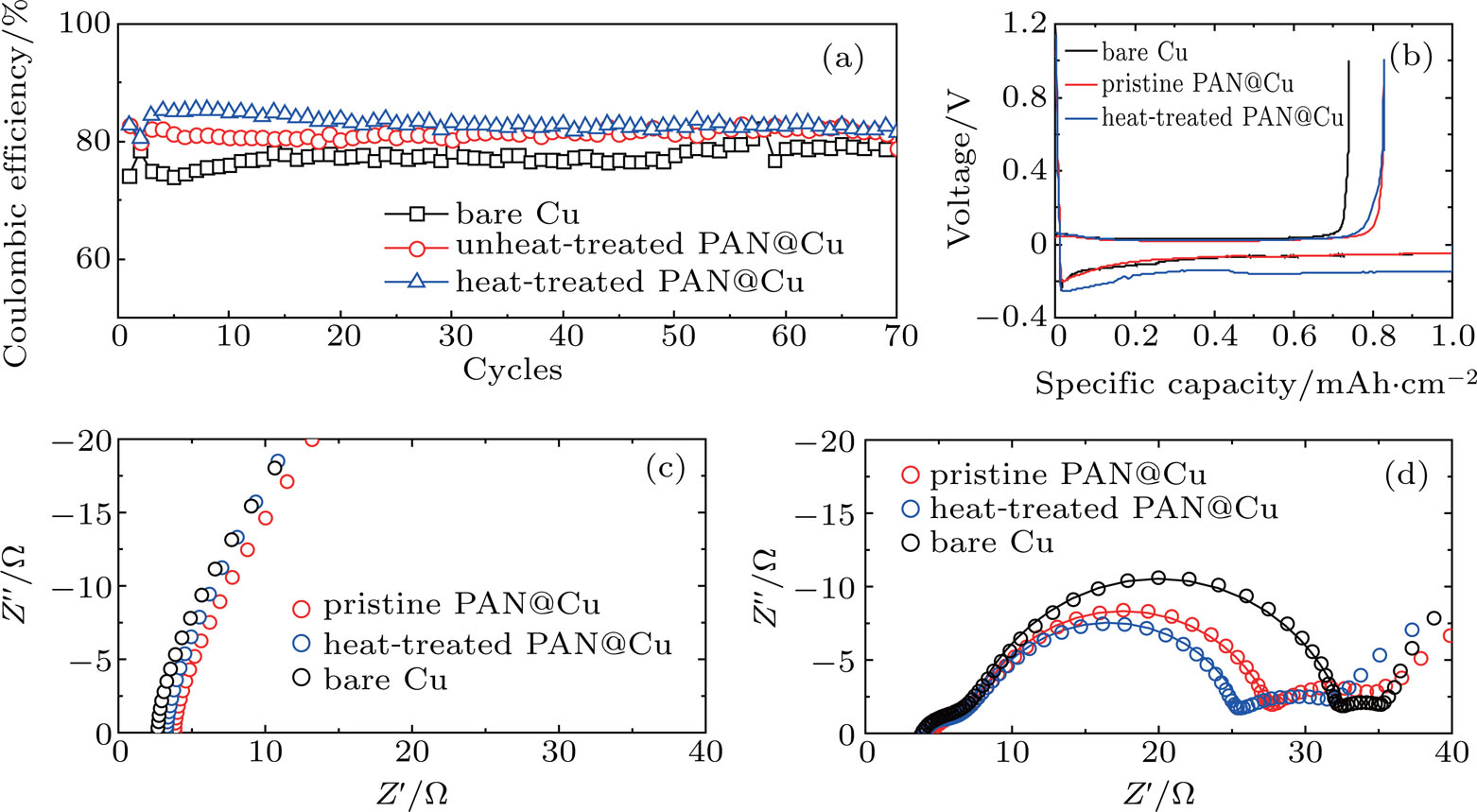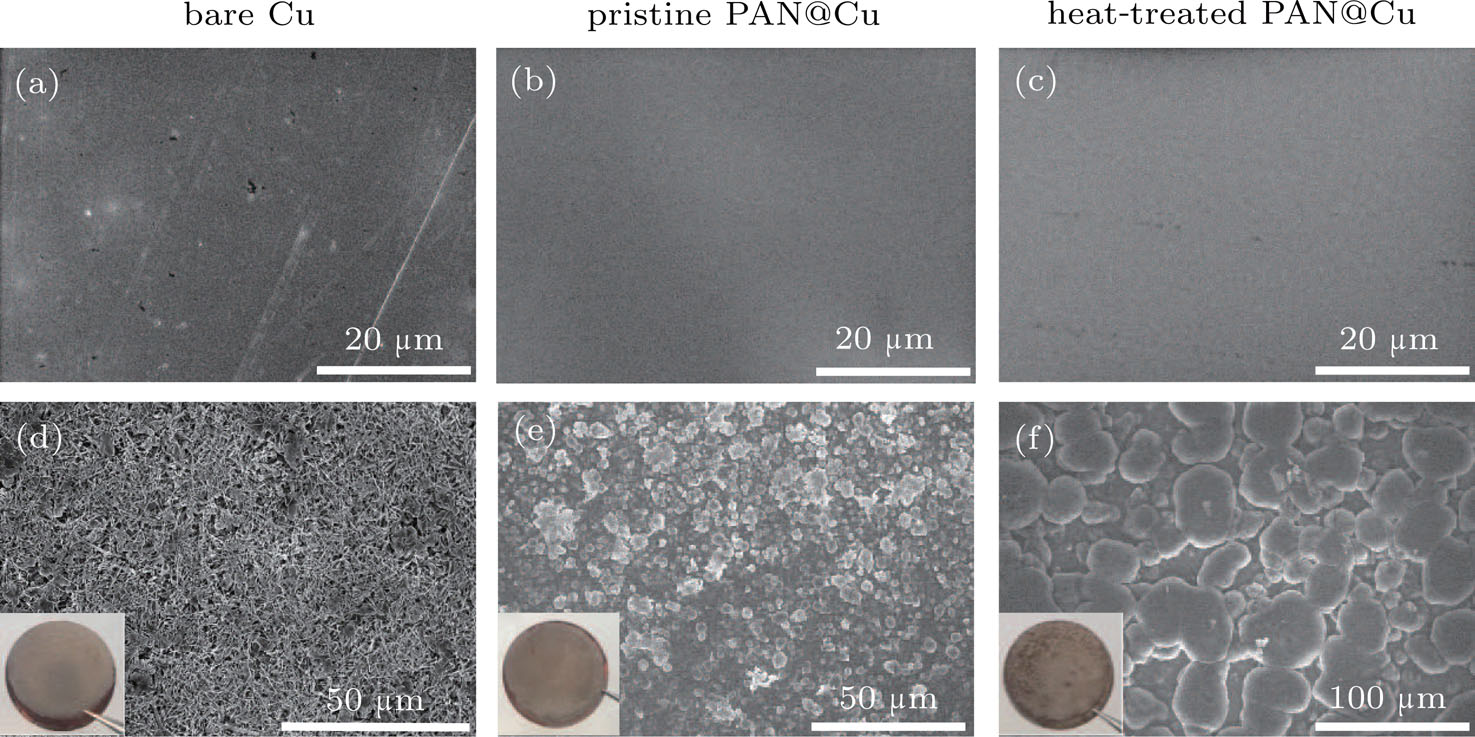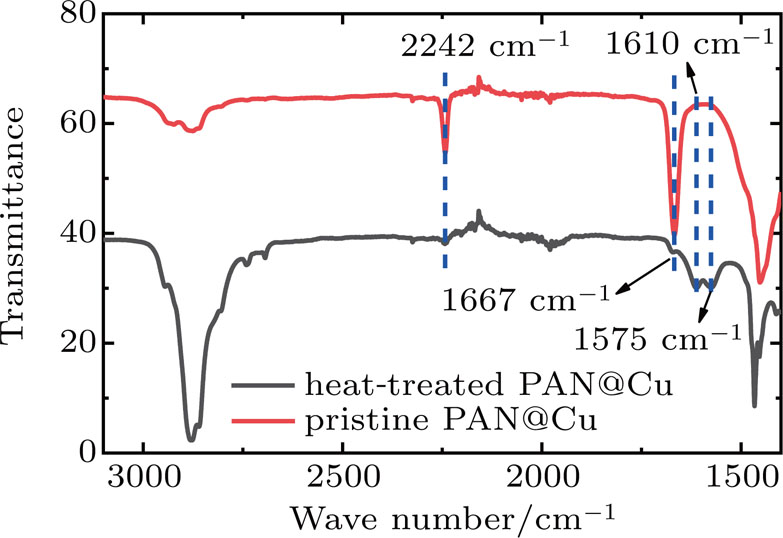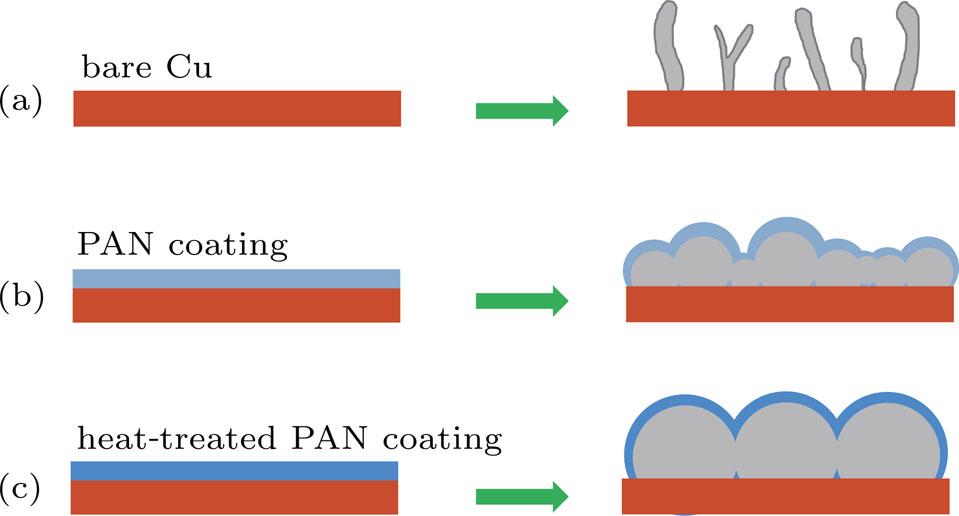† Corresponding author. E-mail:
Project supported by the National Natural Science Foundation of China (Grant Nos. 51822211 and 51802342) and the State Grid Technology Project, China (Grant No. DG71-17-010).
High chemical reactivity, large volume changes, and uncontrollable lithium dendrite growth have always been the key problems of lithium metal anodes. Coating has been demonstrated as an effective strategy to protect the lithium metal. In this work, the effects of polyacrylonitrile (PAN)-based coatings on electrodeposited lithium have been studied. Our results show that a PAN coating layer provides uniform and dendrite-free lithium deposition as well as better cycling performance with carbonate electrolyte. Notably, heat treatment of the PAN coating layer promotes the formation of larger deposit particle size and higher coulombic efficiency (85%). The compact coating layer of heat-treated PAN with a large Young modulus (82.7 GPa) may provide stable protection for the active lithium. Improved homogeneity of morphology and mechanical properties of heat-treated PAN contribute to the larger deposit particles. This work provides new feasibility to optimize the polymer coating through rational modification of polymers.
Lithium metal anode has become particularly attractive as an ultimate anode for next-generation high-energy batteries due to the high theoretical specific capacity (3860 mAh/g) and the most negative equilibrium potential (−3.04 V vs. standard hydrogen electrode).[1,2] Tremendous research efforts have been devoted to lithium metal anode since the 1970s, however, the commercialization of lithium metal batteries (LMBs) is still hindered by poor cycling life and the severe safety hazard.[3,4] Major challenges for LMBs come from the problems of lithium metal anode including high chemical reactivity, large volume changes, and uncontrollable lithium dendrite growth.[5–7] The former two issues likely result in inhomogeneous lithium deposition which is the direct incentive of the latter one. In order to overcome these problems, some prominent strategies have been proposed such as mechanically blocking with solid electrolyte,[8–11] using super-concentrated electrolyte,[12,13] controlling solid electrolyte interface (SEI) forming with electrolyte additives,[14,15] modifying interface,[16–18] designing three-dimensional (3D) structured anode,[19–21] etc.
In addition, building an artificial SEI on lithium metal by polymer coating has shown promising results.[22–25] First, the polymer layer can avoid direct contact between lithium metal and electrolyte, and therefore decrease the continuous consumption of active lithium. Then, the flexible polymer layer can improve the coherency of interfacial stress distribution and accommodate the interface fluctuation during lithium plating and stripping. Finally, a homogeneous polymer layer can make the lithium ion flux uniform, reduce the uncontrolled lithium nucleation and growth, and thus suppress the dendrite growth.[26] Cui et al.[27] investigated the effects of different kinds of polymer coatings on electrodeposited lithium. Their results showed that high dielectric constant polymers can provide higher exchange currents and promote larger lithium deposits. Polyacrylonitrile (PAN) with polar nitrile groups in the side chain has a relative high dielectric constant and, therefore, could be an ideal coating material for lithium metal. PAN-based polymer electrolyte has been intensively investigated owing to its high ionic conductivity, great homogeneity, and good mechanical properties.[28–30]
Herein, we investigate the effects of PAN-based polymer coating as an artificial solid electrolyte interphase on electrodeposited lithium. We find that the polymer coating composed of polyacrylonitrile and lithium bis(trifluoromethylsulphonyl)imide (LiTFSI) is able to suppress the lithium dendrites and improve the coulombic efficiency in Li–Cu cells with carbonate based electrolyte. In addition, heat treatment can further promote the coating effects on regulating lithium deposition and reducing side reactions, leading to improved cycling performance over the pristine ones. This can be attributed to the fact that heat treatment improves the homogeneity, compaction, and mechanical properties through changing the chemical structure of the PAN polymer matrix which could be indicated by the attenuated total reflection Fourier transformed infrared (ATR-FTIR) spectrum.
Prior to sample preparation, PAN (Mw = 150,000, Sigma Aldrich) was dried at 50 °C in vacuum oven for 12 hours. 


Electrochemical measurements were performed using CR2023 coin-type cells. The working electrodes, including Cu electrodes with no polymer coating, pristine PAN coating, and heat-treated PAN coating, were punched into 14 mm diameter discs, and paired with 15 mm diameter lithium electrodes using polypropylene separators. 
Cycling tests were carried out galvanostatically at a current density of 

Hitachi S-4800 scanning electron microscopy (SEM) was employed to determine the surface morphology of the working electrodes at 10.0 kV. The electrodes after the 1st half-cycle of lithium deposition were washed with DMC and dried in a vacuum chamber before SEM analysis. The samples were prepared in an Ar-filled glovebox and transferred to the SEM chamber by a sealed transfer box.
The ATR-FTIR spectroscopy was performed at Vertex 70 Brucker to characterize the structure change of heat-treated PAN thin film with LiTFSI. The roughness and mechanical properties of the PAN coating layer were measured with peak force quantitative nanomechanical (PFQNM) mode by a scanning probe microscope (SPM, Bruker Multimode 8) equipped in an Ar-filled glove box (H2O and 
Li–Cu Cells are adopted to demonstrate the effects of PAN-based polymer coating on cycling performance. Figure 

The electrochemical impedance spectra of Li–Cu cells before (Fig.
To evaluate the dendrite suppression ability of PAN-based polymer coating, the morphologies of electrodeposited lithium on the working Cu electrodes are investigated by SEM. For the bare Cu electrode, with some tiny scratches on the pristine surface (Fig. 

In contrast, the Cu electrode with PAN coating shows a smooth surface (Figs.
The quality of the SEI layer is critical for the performance of electrodeposited lithium. When lithium deposits on bare Cu, the uncontrollable SEI forming process leads to an uneven and fragile interface. In addition, the large volume change during lithium deposition will cause the formation of cracks on the SEI. Both of these factors contribute to the local enhancement of the Li-ion flux, which will result in the formation of lithium dendrites. However, the well-distributed PAN coating layers can make the Li-ion flux and lithium deposition uniform, and thus suppress the lithium dendrites.
In order to investigate the intrinsic reason, the roughness and mechanical properties of the PAN coating are studied by scanning probe microscopy. As can be seen from Figs.
 | Fig. 3. Morphology of (a) pristine PAN coating and (b) heat-treated PAN coating on Cu electrode. Young modulus mapping of (c) pristine PAN coating and (d) heat-treated PAN coating on Cu electrode. |
It is supposed that modulus on the order of 1 GPa would be sufficient to suppress lithium dendrites,[32] so that the heat-treated PAN coating should be a strong physical barrier to prevent the dendrite growth. The homogeneity of mechanical strength of heat-treated PAN is also improved compared to the pristine PAN, which may be helpful for unifying the interface stress distribution of electrodeposited lithium.
Figure
On the basis of the above results, the effects of PAN coating layer on the electrodeposited lithium are illustrated in Fig.
A higher coulombic efficiency is also observed on the Cu electrode with heat-treated PAN coating. There are three factors that may contribute to this. First, the polymer coating can improve the coulombic efficiency through avoiding the direct contact between electrolyte and active lithium, and heat treatment improves the compaction and mechanical strength which provides better protection. Second, the heat-treated PAN may be less reactive to lithium because of the chemical change during heat treatment. Third, it promotes larger deposits with smaller surface areas and minimizes the exposure of the fresh lithium at the interface.
In summary, we propose a PAN-based polymer coating as an artificial solid electrolyte interphase over electrodeposited lithium. Cu electrodes with no coating, pristine PAN coating, and heat-treated PAN coating are prepared to examine the effects of PAN coatings on lithium deposition morphology and cycling performance. It is demonstrated that the PAN coating leads to uniform and dendrite-free lithium deposition as well as relatively high coulombic efficiency through homogenizing lithium deposition and reducing the side reactions of active lithium. Notably, heat treatment is proved to be an effective modification of PAN coating. PAN molecular structure change will take place during heat treatment with obvious color change. The heat-treated PAN coating shows better compaction, higher mechanical strength, and improved homogeneity of morphology, which contribute to larger lithium deposits with a higher coulombic efficiency. This work provides strategies for the design and modification of polymer coating to achieve a lithium metal anode with good stability and high coulombic efficiency. Thus, constructing artificial SEI with good chemical composition, compaction, homogeneity, and mechanics is an effective method for building better lithium metal batteries.
| [1] | |
| [2] | |
| [3] | |
| [4] | |
| [5] | |
| [6] | |
| [7] | |
| [8] | |
| [9] | |
| [10] | |
| [11] | |
| [12] | |
| [13] | |
| [14] | |
| [15] | |
| [16] | |
| [17] | |
| [18] | |
| [19] | |
| [20] | |
| [21] | |
| [22] | |
| [23] | |
| [24] | |
| [25] | |
| [26] | |
| [27] | |
| [28] | |
| [29] | |
| [30] | |
| [31] | |
| [32] | |
| [33] | |
| [34] | |
| [35] |











